Last week, Mark Zuckerberg announced Facebook’s plans for a new campus, a 420,000 square foot single-story warehouse made to look like “a hill in nature,” one giant room fitting thousands of people. He described their aspiration as wanting to build “the perfect engineering space.”
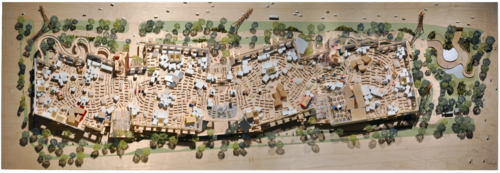
I admit that Zuck’s statement caught me off guard because I dislike the typical open floor plan office and so do most engineers that I know. Many engineers wear headphones to create the missing wall so that they can concentrate and focus on coding without distraction. We chose the small offices at WeWork in SOMA, SF, over co-working for those reasons.
The New York Times reported that recent research supported the hunch that open floor plan offices reduce productivity. The research showed that ambient conversations at work and a noisy office space contributed to “a decline of 5 percent to 10 percent on the performance of cognitive tasks requiring efficient use of short-term memory, like reading, writing and other forms of creative work.” According to the researcher, “Noise is the most serious problem in the open-plan office, and speech is the most disturbing type of sound because it is directly understood in the brain’s working memory.”
Nevertheless, the open floor plan office has become a shibboleth of startup culture. It reflects our rejection of hierarchy, and our embrace of agility, collaboration and creativity, and as a result, many startups take the open floor plan for granted.
We’ve recently visited two startups, Shopify and Zappos, that are reconsidering and riffing off of the standard startup open floor plan office, and we’ve been inspired by what they’ve come up with to ensure that engineers have the relative solitude that they need to get in the zone, without reverting away from the promise of the open floor plan for serendipity, collaboration and work happiness.
Work and Play at Shopify
Shopify, an e-commerce platform, is on their fourth office in their sixth year of existence, so they’ve learned a thing or two about offices. One important thing they’ve learned is that they don’t like open floor plans.
At Shopify, they work in pods, which are rooms of the 6-8 people you work closely with on a day-to-day basis. The pods shoot off from a central hallway loop. On the outside of the loop are the pods, and on the inside are small private meeting rooms and conference rooms.
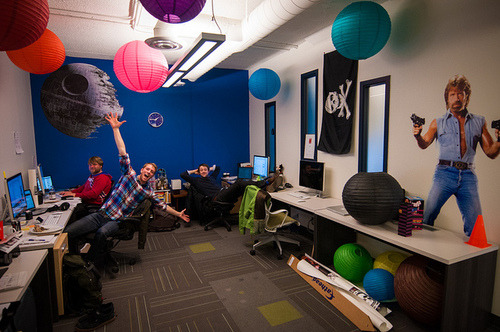
Attached to the core of the office is a big open space called the Annex where they hold their weekly all-hands meeting and host events in the community. Daily free lunch and a big, central kitchen with free drinks and snacks facilitate collaboration and serendipity, but when people open themselves up to it, not on a constant barrage.
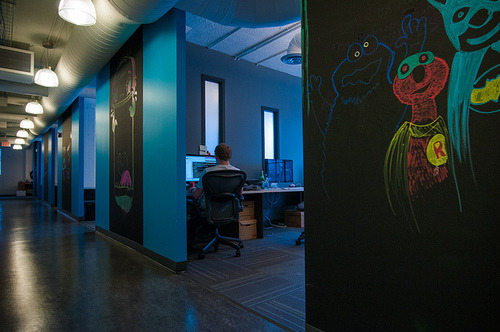
The configuration shows the value the company puts in quiet, distraction-free coding with your core collaborators. Open floor plan offices are noisy and distracting and that can prevent engineers from getting in a state of flow. There was definitely plenty of fun to be had in the office, but those areas weren’t in places that would create distractions for others trying to work.
To me, this reflected an organizational value of work-life segmentation. We worked out of Shopify’s office for a week, and we were shocked to see engineers come in at 9 and leave by 5 on a daily basis. Similarly, concentrated work happens in the work areas and hanging out and relaxing happens in the lounge areas. In Silicon Valley, work and play is all mixed up together so it sometimes feels like you’re expected to work and play all at the same time all the time.
What “Open” Means to Zappos
Their offices look like total mayhem to the outside observer and it’s hard not to wonder how anything gets done, especially with the world-famous Zappos tour rolling through the office nonstop. (Noticably absent from the tour, however, was the engineering team, which is housed in a separate building.)
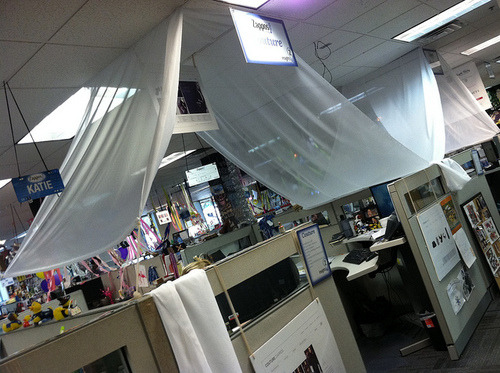
They have a open floor plan at Zappos with team-oriented bullpens, but for them, that’s far from sufficient in ensuring serendipitous interactions and a culture where everyone knows everyone. Zappos CEO Tony Hsieh is famous for taking measures to hack serendipity like only allowing Zappos employees to enter through one door in the building to force spontaneous encounters.
Zappos is taking the concept of the “open floor plan” to the next level with what you might call an open floor plan community. The irony of the open floor plan Silicon Valley corporate campus is that they’re typically cloistered away from the community at large in their own ivory tower. Openness, collaboration, and nonhierarchical organization is the order of the day, but among themselves only.
Zappos’s $350 million project to bring its HQ from suburbia into downtown and revitalize downtown Las Vegas reimagines what an open floor plan office can be by opening itself up the entire community. It’s inspired by the idea that companies become more productive when they collide with people and ideas in the broader community, and the entire plan is organized to facilitate interactions not just between employees, but within the community, from the placement of the buildings and public spaces, to the grassroots investment model and the community-oriented projects being funded.
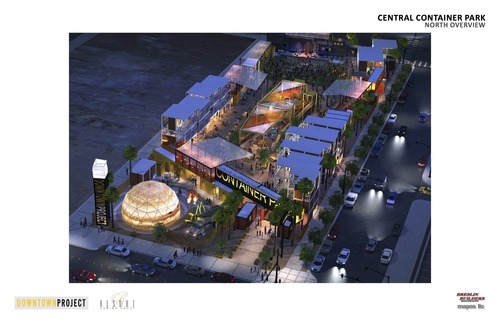
In some ways, the Downtown Project is an experiment in taking the open floor plan office to its logical extreme. It blurs the distinction between companies in the same way that co-working does (no wonder co-working is a big part of the Downtown Project) by subsuming individuals into a broader community.
What’s your take on open floor plan offices?
How does your company balance work and play and openness and distinction? We’d love to hear your thoughts in the comments.
